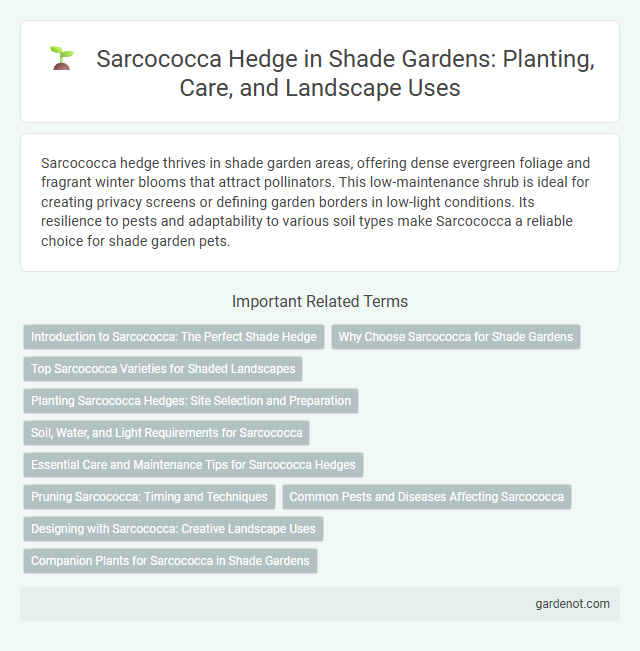Sarcococca hedge thrives in shade garden areas, offering dense evergreen foliage and fragrant winter blooms that attract pollinators. This low-maintenance shrub is ideal for creating privacy screens or defining garden borders in low-light conditions. Its resilience to pests and adaptability to various soil types make Sarcococca a reliable choice for shade garden pets.
Introduction to Sarcococca: The Perfect Shade Hedge
Sarcococca, commonly known as sweet box, thrives in shaded gardens, making it an ideal choice for creating dense, evergreen hedges that provide year-round privacy and fragrance. This slow-growing shrub features glossy dark green leaves and produces small, highly fragrant white flowers in winter, enhancing the garden's appeal during colder months. Its tolerance to deep shade and adaptability to various soil types ensure a low-maintenance, attractive hedge for shaded areas.
Why Choose Sarcococca for Shade Gardens
Sarcococca is an ideal choice for shade gardens due to its evergreen foliage and exceptional tolerance for low light conditions, creating year-round interest and dense privacy. Its fragrant winter blooms attract pollinators and add seasonal scent, enhancing the garden's sensory appeal. The plant's low maintenance and adaptability to various soil types make it perfect for creating lush, resilient shade hedges.
Top Sarcococca Varieties for Shaded Landscapes
Sarcococca hedge varieties such as Sarcococca confusa, Sarcococca hookeriana var. humilis, and Sarcococca ruscifolia thrive in shaded landscapes, delivering dense, evergreen foliage ideal for privacy and wind protection. These varieties produce fragrant white flowers in winter, attracting pollinators and enhancing garden aroma during dormant seasons. Their low-maintenance growth and tolerance to deep shade make them top choices for sustainable shade garden designs.
Planting Sarcococca Hedges: Site Selection and Preparation
Sarcococca hedges thrive in well-drained, fertile soils with consistent moisture and prefer shaded to partially shaded sites to maintain glossy, evergreen foliage. Preparing the planting site involves loosening soil to enhance root penetration and incorporating organic matter such as compost to improve soil structure and nutrient availability. Proper spacing of 30 to 45 cm between plants ensures adequate airflow and healthy growth for dense, fragrant hedges in shade garden settings.
Soil, Water, and Light Requirements for Sarcococca
Sarcococca thrives best in well-drained, humus-rich soil with a slightly acidic to neutral pH, making it ideal for shaded garden areas. It requires consistent moisture but should not be waterlogged, as excess water can lead to root rot, so regular watering during dry periods is essential. This evergreen shrub grows optimally in partial to full shade, tolerating deep shade, which makes it perfect for understory planting in shade gardens.
Essential Care and Maintenance Tips for Sarcococca Hedges
Sarcococca hedges thrive in consistently moist, well-drained soil and prefer partial to full shade, making them ideal for shaded garden areas. Regularly prune after flowering in late winter to maintain shape and encourage dense growth, while removing any dead or damaged branches to promote plant health. Mulching with organic material helps retain moisture and suppress weeds, ensuring optimal conditions for Sarcococca's slow-growing but hardy nature.
Pruning Sarcococca: Timing and Techniques
Pruning Sarcococca hedges is best done in late winter or early spring before new growth begins to maintain a dense, tidy appearance. Use sharp, clean tools to remove dead or damaged stems and selectively thin out older branches to encourage fresh shoots. Regular pruning enhances air circulation, reduces disease risk, and promotes healthier, more vibrant foliage year-round.
Common Pests and Diseases Affecting Sarcococca
Sarcococca hedge is susceptible to common pests such as scale insects and aphids that can cause leaf distortion and sap loss. Fungal diseases like powdery mildew occasionally affect the foliage, leading to reduced photosynthesis and weakened growth. Proper sanitation, adequate air circulation, and prompt removal of affected plant parts are essential to maintain a healthy Sarcococca hedge.
Designing with Sarcococca: Creative Landscape Uses
Sarcococca hedge thrives in shade gardens, offering dense, evergreen foliage that creates a lush, year-round backdrop. Its fragrant winter blooms enhance sensory appeal, perfectly suited for borders or underplanting beneath trees. Incorporate Sarcococca to define pathways, soften hardscape edges, or provide privacy in low-light garden areas.
Companion Plants for Sarcococca in Shade Gardens
Sarcococca hedges thrive in shade gardens and pair well with companion plants such as ferns, hostas, and hellebores, which complement their evergreen foliage and winter fragrance. These shade-loving plants share similar soil and moisture requirements, creating a lush, layered effect that enhances garden biodiversity. Incorporating pulmonaria and epimedium alongside Sarcococca also boosts seasonal interest with varied textures and early spring blooms.
Sarcococca hedge Infographic

 gardenot.com
gardenot.com